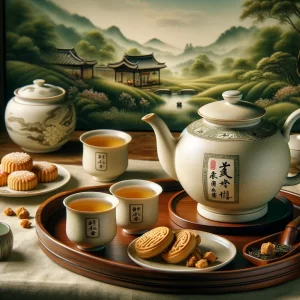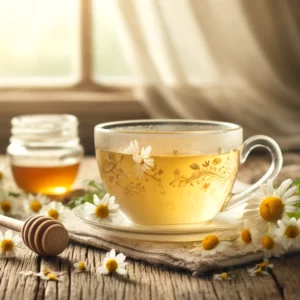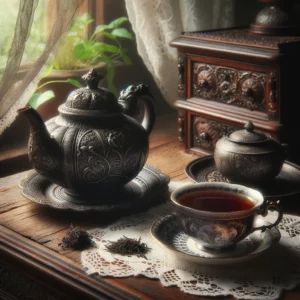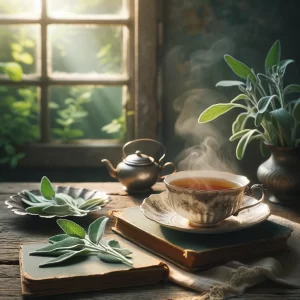Pouchong Oolong Tea, with its delicate balance between green and oolong teas, offers a unique taste that captivates tea lovers around the world. Its light, floral aroma and nuanced flavor profile make it a fascinating subject for anyone looking to deepen their appreciation of tea. In this blog post, we’ll dive into everything from the origins and special qualities of Pouchong Oolong Tea to tips on brewing the perfect cup and exploring the best food pairings. Whether you’re a seasoned tea aficionado or new to the world of teas, there’s something here for everyone to enjoy and learn.
Table of Contents
- Introduction
- The Origins and History of Pouchong Oolong Tea
- What Makes Pouchong Oolong Tea Special?
- Brewing the Perfect Cup of Pouchong Oolong Tea
- Creative Ways to Enjoy Pouchong Oolong Tea
- The Best Food Pairings with Pouchong Oolong Tea
- Where to Find Pouchong Oolong Tea and Tips for Storage
- Cultivation and Processing of Pouchong Oolong Tea
- Conclusion
Introduction
Pouchong Oolong Tea is a gem in the world of teas. It’s a lightly oxidized tea, sitting between green and oolong teas, making it perfect for those who love a subtle floral aroma and a soft, soothing taste. Pouchong Tea is particularly popular for its versatility and gentle flavor, making it an excellent choice for any time of day. In this article, we’ll explore the origins, unique characteristics, and ways to enjoy Pouchong Oolong Tea, offering insights for both new enthusiasts and seasoned tea lovers.
The Origins and History of Pouchong Oolong Tea
Pouchong Oolong Tea originated in Taiwan, a place renowned for its high-quality teas. The name “Pouchong” comes from the Chinese term meaning “wrapped,” referring to the traditional method of wrapping the leaves in paper during the drying process. This tea gained prominence for its distinct flavor and aroma, a result of the unique climate and soil conditions of Taiwan.
Historically, Pouchong Tea was one of the first teas to be exported from Taiwan, introducing the world to the island’s tea production capabilities. Its light oxidation process, which sets it apart from other oolong and green teas, contributes to its mild flavor and has made it a favorite among tea enthusiasts worldwide.
What Makes Pouchong Oolong Tea Special?
Pouchong Oolong Tea is celebrated for its exceptional flavor profile. It is less oxidized than traditional oolong teas, giving it a lighter taste and a more pronounced floral scent. This tea is often described as having hints of melon, almond, and rose, making it a refreshing choice for tea drinkers.
Key Characteristics:
- Flavor: Light, with floral notes and a smooth finish.
- Aroma: Sweet and fragrant, often likened to fresh flowers.
- Color: Bright greenish-yellow, clear, and vibrant.
What sets Pouchong Tea apart is its crafting process, which involves careful temperature control and timing to ensure the leaves are perfectly oxidized. This meticulous process results in a tea that’s both rich in flavor and aroma.
Brewing the Perfect Cup of Pouchong Oolong Tea
To fully appreciate Pouchong Oolong Tea, brewing it correctly is crucial. Here’s a simple guide to making the perfect cup:
- Water Temperature: Aim for water that’s between 180°F to 190°F. Too hot, and you risk burning the leaves; too cool, and the tea won’t properly steep.
- Amount: Use about 1-2 teaspoons of loose leaf tea per 8 ounces of water.
- Steeping Time: Start with a steep time of 3-5 minutes. Adjust according to taste, allowing for a longer steep if you prefer a stronger flavor.
Tips for Success:
- Always use fresh, filtered water for the best taste.
- Consider a second or third infusion to explore different flavor depths. Pouchong Tea leaves can be reused, revealing new layers of taste with each steep.
Creative Ways to Enjoy Pouchong Oolong Tea
Beyond sipping it plain, Pouchong Oolong Tea can be a versatile ingredient in various recipes or enjoyed in innovative ways:
- Tea-Infused Desserts: Use it to make a Pouchong Tea-infused cake or gelato for a subtle tea flavor.
- Iced Tea: Brew a stronger batch, let it cool, and serve over ice for a refreshing drink.
- Cocktails and Mocktails: Mix it with fruits and herbs to create unique beverages.
The Best Food Pairings with Pouchong Oolong Tea
Pairing food with Pouchong Tea can enhance both the tea and the meal. Here are some suggestions:
- Savory: Light sandwiches, seafood dishes, or salads.
- Sweet: Fruit tarts, vanilla-flavored desserts, or scones.
Where to Find Pouchong Oolong Tea and Tips for Storage
Finding high-quality Pouchong Tea can make all the difference. Look for reputable tea shops or online retailers specializing in Taiwanese teas. When selecting Pouchong Tea, opt for leaves that are fresh and aromatic, avoiding those that appear dull or stale.
Storage Tips:
- Keep it in a cool, dark place away from direct sunlight and moisture.
- Use an airtight container to preserve the aroma and flavor.
Cultivation and Processing of Pouchong Oolong Tea
The cultivation and processing of Pouchong Tea are art forms in themselves. Grown primarily in the Wen Shan region of Taiwan, the tea benefits from the area’s foggy, cool climate, which is ideal for producing its signature aroma and taste. After plucking, the leaves undergo a precise oxidation process, followed by rolling and drying, which helps to develop their unique flavor profile.
Conclusion
Pouchong Oolong Tea is a delightful treasure from Taiwan, offering a unique taste experience that bridges the gap between green and oolong teas. From its fascinating history to the intricate process of brewing the perfect cup, Pouchong Tea invites tea lovers to explore its subtle complexities. Whether enjoyed on its own or as part of a creative recipe, Pouchong Oolong Tea is sure to enchant and refresh all who try it. Let’s embrace the journey of discovering the many facets of this exquisite tea.
We’ve explored the gentle world of Pouchong Oolong Tea, delving into its origins, special characteristics, and the best ways to enjoy its delicate flavors. Whether you’re new to tea or a seasoned enthusiast, Pouchong offers a unique taste that’s both refreshing and comforting. Happy brewing!
Try Pouchong Oolong Tea
“As an Amazon Associate I earn from qualifying purchases.”
[azonpress template=”grid” asin=”B019S5V0PQ,B007W0DW3S”]



